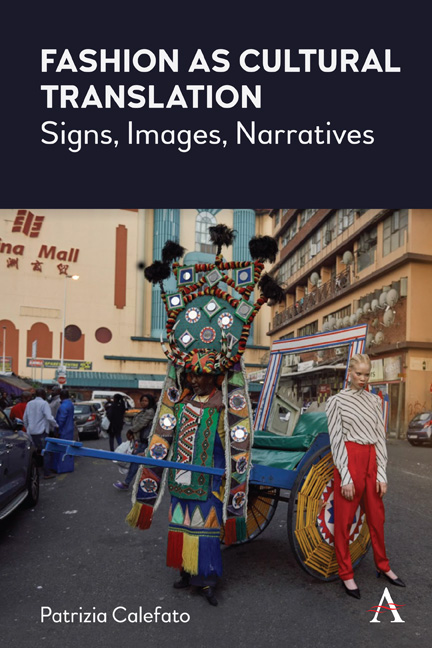Book contents
- Frontmatter
- Contents
- Introduction: Fashion as Cultural Translation in the Hyperconnected World
- Supplement to the Introduction: Fashion, the Hyperconnected World and Coronavirus
- 1 Time
- 2 Spaces
- 3 Fashion as Cultural Tradition: Italian Style
- 4 Fashion as Cultural Translation
- 5 Clothed Bodies
- 6 The Body as Text
- 7 Humans and Beyond
- 8 Fashion and the ‘Second Nature’
- 9 Fashion, Communication and Converging Media
- 10 Fashion Narratives in Visual Culture
- Conclusions: Fashion as an Idea about the Future
- References
- Index
4 - Fashion as Cultural Translation
Published online by Cambridge University Press: 18 February 2021
- Frontmatter
- Contents
- Introduction: Fashion as Cultural Translation in the Hyperconnected World
- Supplement to the Introduction: Fashion, the Hyperconnected World and Coronavirus
- 1 Time
- 2 Spaces
- 3 Fashion as Cultural Tradition: Italian Style
- 4 Fashion as Cultural Translation
- 5 Clothed Bodies
- 6 The Body as Text
- 7 Humans and Beyond
- 8 Fashion and the ‘Second Nature’
- 9 Fashion, Communication and Converging Media
- 10 Fashion Narratives in Visual Culture
- Conclusions: Fashion as an Idea about the Future
- References
- Index
Summary
Visual Culture and Cultural Translation
Today's fashion theory (Calefato 2003) has established a tight relationship with postcolonial culture and critique. The latter is understood as a theoretical and historical position on the present and the past, as well as on the conditions of production of social discourse, everyday and academic debates and our ways of ‘seeing’ and representing the world and power relationships. A complex network of tensions, meanings and values beyond the dimension of clothing underlies fashion. This complexity has at its heart the body and the modalities in which it self-represents, disguises, exists in the world, comes to terms with and fights against stereotypes and myths. Today, the clothed body in the public sphere has developed a central role which is political as well as aesthetic and based on customs. As this chapter seeks to demonstrate, clothing and accessories represent, in both an explicit and hidden way, instances and social tensions in a constant process of cultural translation.
In Primitive Passions, Rey Chow focuses on cinema as an ethnographic form wherein takes place a process of translation among culture in the postcolonial world (1995, 175– 202). Chow's starting assumption is provided by Laura Mulvey's ‘Visual Pleasure and Narrative Cinema’, a landmark text within feminist visual studies (1975). In her article, Mulvey describes the conditions of ‘looking at’ and ‘being looked at’ as hierarchically uneven positions: the former being proper to men, the latter to women. Moving on to the study of cultures, Chow extends this model of vision to the way Western cultures relate with non-Western ones: the Western world ‘looks at’, and the non-Western world ‘is looked at’. However, this statement is not enough. According to Chow, we should also mention that
the state of being looked at not only is built into the way non-Western cultures are viewed by Western ones; more significantly it is part of the active manner in which such cultures represent ethnographize themselves. (1995, 180)
Through this hypothesis, Chow tackles the relationship between the ‘original’ and the ‘translation’ between cultures. She states that the assumed ‘original’ is a construction based on the condition of ‘to-be-looked-at-ness’, which functions as an ‘optical unconscious’ (Ibid.).
- Type
- Chapter
- Information
- Fashion as Cultural TranslationSigns, Images, Narratives, pp. 33 - 42Publisher: Anthem PressPrint publication year: 2021



